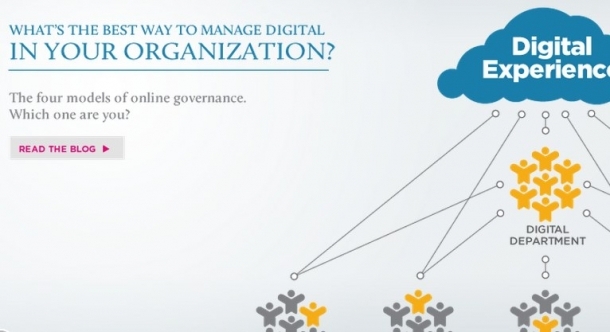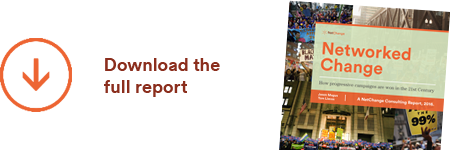In 2011 we worked closely with our colleague Michael Silberman, who was then a consultant at EchoDitto and now runs the global Mobilization Lab at Greenpeace, on establishing key patterns that we saw institutions use to manage their digital programs.
Since we first published this article in the Stanford Social Innovation Review, and after doing presentations and projects for nearly 100 digital programs since then, we find the patterns have held surprisingly firm to this day.
Here is a short refresher on the four models for how we see the digital program managed at institutions.
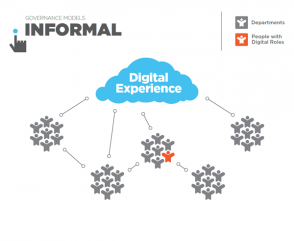
Informal teams are typically a legacy of how the Internet grew up organically in institutions: digital work is driven by program priorities and budgets, and capacity is loosely and randomly dispersed across various functions and departments. The structure would more accurately be called un-managed, and is marked by an extreme lack of brand consistency, inefficiencies, and an overall rudderless strategy.
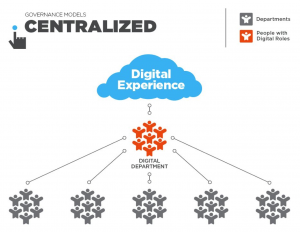 Centralized teams are a much more common model, you put digital in a silo (most often communications), hire a smart person to run it, and it serves the institution from this central place. The many benefits include brand consistency, common tools, and a centralized strategy with clear reporting lines. Unfortunately, these teams can be slow to respond to change, and get bogged down in heavy processes that stifle creativity from the edges.
Centralized teams are a much more common model, you put digital in a silo (most often communications), hire a smart person to run it, and it serves the institution from this central place. The many benefits include brand consistency, common tools, and a centralized strategy with clear reporting lines. Unfortunately, these teams can be slow to respond to change, and get bogged down in heavy processes that stifle creativity from the edges.
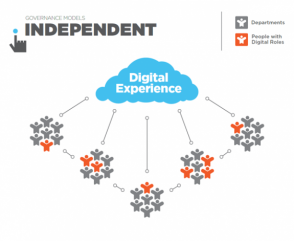 Independent teams see two or three centers of digital leadership established. Some departments run high-performing digital silos (often with their own brands, sites, and social networks), while others with less clout or skills struggle. This model creates a competitive rather than collaborative culture, duplicates resources, and—with no strong digital group setting an integrated vision— creates an inconsistent and confusing user experience.
Independent teams see two or three centers of digital leadership established. Some departments run high-performing digital silos (often with their own brands, sites, and social networks), while others with less clout or skills struggle. This model creates a competitive rather than collaborative culture, duplicates resources, and—with no strong digital group setting an integrated vision— creates an inconsistent and confusing user experience.
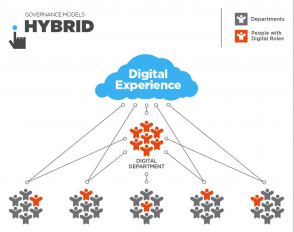 Hybrid teams are the most progressive and most conducive to producing continuous digital innovation. In this model, different business units continue to build their own capacity based on their specific needs, but all digital staffers are connected to and supported by a central digital experience team focused on a few core competencies and directing the whole system toward long-term strategic goals. The culture of the central digital group is one of “open leadership”: service oriented, highly collaborative, connected listeners, who have the technical and content expertise to be high-value strategists. They take on leadership of high-leverage or high-risk projects themselves, but leave space for others to lead on their own initiatives.
Hybrid teams are the most progressive and most conducive to producing continuous digital innovation. In this model, different business units continue to build their own capacity based on their specific needs, but all digital staffers are connected to and supported by a central digital experience team focused on a few core competencies and directing the whole system toward long-term strategic goals. The culture of the central digital group is one of “open leadership”: service oriented, highly collaborative, connected listeners, who have the technical and content expertise to be high-value strategists. They take on leadership of high-leverage or high-risk projects themselves, but leave space for others to lead on their own initiatives.
The hybrid model may sound ideal, and indeed our practice re-structuring digital and communications programs over the last 18 months has largely focused on helping “network” or hybridize entire institutions, however doing so requires a rare alignment of senior leadership around major changes to organizational structure and culture, leaving few stones unturned.
While we see this as one of the most exciting ways to create more nimble, responsive, and ultimately effective social change institutions for our turbulent times, in practice hybrid models are much more organic than most institutions are comfortable with.
It’s one of our key objectives with our 2013 Digital Teams Report to dig much deeper into the world of hybrid teams to shine some much needed insights into this emerging space.

